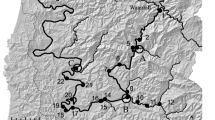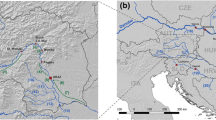Abstract
In 1979 and 1981, a genetic marker was bred into one of the five identifiable subpopulations of pink salmon [Oncorhynchus gorbuscha (Walbaum)] in the Auke Lake drainage in Southeast Alaska. As a result of the marking effort, the frequencies of two malate dehydrogenase (MDH-B1, 2*) alleles were changed in the marked subpopulation, but not in other subpopulations that spawn at different times or places. Between 1983 and 1989, the marker allele frequencies were monitored in many of these subpopulations and in early- and late-run pink salmon spawning in nearby Waydelich Creek, located approximately 1 km away. Changes in allele frequencies at MDH-B1, 2*, used to obtain direct estimates of average migration rates (m) from the marked to the unmarked subpopulations, revealed little or no introgression into early subpopulations or into nearby Waydelich Creek. Moreover, spatially distinct late-run Auke Creek subpopulations were not immediately overrun by the more abundant marked subpopulation. These observations suggest that genetic isolation exists between temporally distinct spawning runs and that small temporal and spatial (or ecological) differences contribute to population structure. These observations should be considered in taking actions that affect conservation and harvest management or extensive culture of salmonids.
Similar content being viewed by others
References
Allendorf, F.W. & G.H. Thorgaard, 1984. Tetraploidy and the evolution of salmonid fishes, pp. 1–53 in Evolutionary Genetics of Fishes, edited by B.J. Turner. Plenum Publishing, New York.
Bams, R.A., 1976. Survival and propensity for homing as affected by presence or absence of locally adapted paternal genes in two transplanted populations of pink salmon. J. Fish. Res. Bd. Can. 33: 2716–2725.
Bjerknes, V., 1977. Evidence of natural production of pink salmon fry Oncorhynchus gorbuscha in Finmark, North Norway. Astarte 10: 5–8.
Boyer, S.H., D.C. Fainer & D.M.A. Naughton, 1963. Myoglobin: inherited structural variation in man. Science 140: 1228–1231.
Clayton, J.W. & D.N. Tretiak, 1972. Amine-citrate buffers for pH control of starch gel electrophoresis. J. Fish. Res. Bd. Can. 29: 1169–1172.
Davidson, F.A., 1934. The homing instinct and age of maturity of pink salmon (Oncorhynchus gorbuscha). Bull. U.S. Bur. Fish. 48: 27–39.
Emery, L., 1981. Range extension of pink salmon (Oncorhynchus gorbuscha) into the lower Great Lakes. Fisheries (Bethesda) 6: 7–10.
Fukushima, M. & W.W. Smoker, 1997. Determinants of stream life, spawning efficiency, and spawning habitat in the Auke Lake system, Alaska. Can. J. Fish. Aquat. Sci. 54: 96–104.
Gharrett, A.J. & J.E. Seeb, 1990. Practical and theoretical guidelines for genetically marking fish populations. Am. Fish. Soc. Symp. 7: 407–417.
Gharrett, A.J. & W.W. Smoker, 1991. Two generations of hybrids between even-and odd-year pink salmon (Oncorhynchus gorbuscha): a test for outbreeding depression? Can. J. Fish. Aquat. Sci. 48: 1744–1749.
Gharrett, A.J., W.W. Smoker, R.R. Reisenbichler & S.G. Taylor, 1999. Outbreeding depression in hybrids between odd-and evenbroodyear pink salmon. Aquaculture 173: 117–129.
Habicht, C., S. Sharr, D. Evans & J.E. Seeb, 1998. Coded wire tag placement affects homing ability in pink salmon. Trans. Am. Fish. Soc. 127: 652–657.
Helle, J.H., 1981. Significance of the stock concept in artificial propagation of salmonids of Alaska. Can. J. Fish. Aquat. Sci. 38: 1665–1671.
Hindar, K., N. Ryman & F. Utter, 1991. Genetic effects of cultured fish on natural fish populations. Can. J. Fish. Aquat. Sci. 48: 945–957.
Hynes, J.D., E.H. Brown, J.H. Helle, N. Ryman & D.A. Webster, 1981. Guidelines for culture of fish stocks for resource management. Can. J. Fish. Aquat. Sci. 38: 1867–1876.
Jones, D.J. & G. Thomason, 1984. US/Canada salmon stock interception research southern southeastern Alaska pink salmon (Oncorhynchus gorbuscha) tagging study, 1982. Alaska Department of Fish and Game Informational Leaflet 231, 12 pp.
Kwain, W. & A.H. Lawrie, 1981. Pink salmon in the Great Lakes. Fisheries (Bethesda) 6: 2–6.
Lane, S., A.J. McGregor, S.G. Taylor & A.J. Gharrett, 1990. Genetic marking of an Alaskan pink salmon population, with an evaluation of the mark and marking process. Am. Fish. Soc. Symp. 7: 395–406.
Mantua, N.J., S.R. Hare, Y. Zhang, J.W. Wallace & R.C. Francis, 1997. A Pacific interdecadal climate oscillation with impacts on salmon production. Bull. Am. Meteorol. Soc. 78: 1069–1079.
McGregor, A.J., S. Lane, M.A. Thomason, L.A. Zhivotovsky, W.W. Smoker & A.J. Gharrett, 1998. Migration timing, a life history trait important in the genetic structure of pink salmon. N. Pac. Anadr. Fish. Comm. Bull. 1: 262–273.
Mork, J., 1991. One-generation effects of farmed fish immigration on the genetic differentiation of wild Atlantic salmon in Norway. Aquaculture 98: 267–276.
Neave, F., 1965. Transplants of pink salmon. Fish. Res. Board Can. MS Rep. Series (Biol.) 830: 23 pp.
Press, W.H., B.P. Flannery, S.A. Teukolsky & W.Y. Vetterling, 1986. Numerical Recipes: The Art of Scientific Computing. Cambridge University Press, NY.
Pritchard, A.L., 1938. Transplantation of pink salmon (Oncorhynchus gorbuscha) into Masset Inlet, British Columbia, in the barren years. J. Fish. Res. Board Can. 4: 141–150.
Quinn, T.P., 1984. Homing and straying in Pacific salmon, pp. 357–362 in Mechanisms of Migration in Fishes, edited by J.D. McCleave, G.P. Arnold, J.J. Dodson, & W.H. Neill. Plenum Publishing, New York.
Roys, R.S., 1970. Effects of tectonic deformation on pink salmon runs in Prince William Sound, pp. 220–237 in The Great Alaska Earthquake of 1964: Biology. The National Academy of Sciences, National Research Council, Committee on the Alaska Earthquake, Washington D.C.
Sharp, D., S. Sharr & C. Peckham, 1994. Homing and straying patterns of coded wire tagged pink salmon in PrinceWilliam Sound, pp. 77–82 in Proc. 16th Northeast Pacific Pink Chum Workshop in Juneau, Alaska, 24-26 February 1993. Alaska Sea Grant College report no. 94-02, Alaska Sea Grant College, Fairbanks, AK.
Sokal, R.R. & F.J. Rohlf, 1995. Biometry W.H. Freeman and Co., San Francisco, CA, 3rd edn. 573 pp.
Smoker, W.W. & F.P. Thrower, 1994. Homing propensity in transplanted and native chum salmon. Am. Fish. So. Symp. 15: 575–576.
Taylor, S.G., 1980. Marine survival of pink salmon fry from early and late spawners. Trans. Am. Fish. Soc. 109: 79–82.
Templeton, A.R., 1998. Nested clade analysis and phylogeographic data: testing hypotheses about gene flow and population history. Mol. Biol. Evol. 7: 381–397.
Walker, C.E. & D.B. Lister, 1971. Results of three generations of pink salmon (Oncorhynchus gorbuscha) spawn to the Qualicum River in 1963 and 1964. J. Fish. Res. Bd. Can. 28: 647–654.
Waples, R.S., 1989. Temporal stability of allele frequencies: testing the right hypothesis. Evolution 43: 1236–1251.
Wertheimer, A.C., R.A. Heintz, J.F. Thedinga, J.M. Maselko & S.D. Rice, 2000. Straying of adult pink salmon from their natal stream following embryonic exposure to weathered Exxon Valdez crude oil. Trans. Am. Fish. Soc. 129: 989–1004.
Withler, F.C., 1982. Transplanting Pacific salmon. Can. Tech. Rep. Fish. Aquat. Sci. 1079: v+27 pp.
Author information
Authors and Affiliations
Rights and permissions
About this article
Cite this article
Gharrett, A., Lane, S., McGregor, A. et al. Use of a genetic marker to examine genetic interaction among subpopulations of pink salmon (Oncorhynchus gorbuscha). Genetica 111, 259–267 (2001). https://doi.org/10.1023/A:1013791314900
Issue Date:
DOI: https://doi.org/10.1023/A:1013791314900




